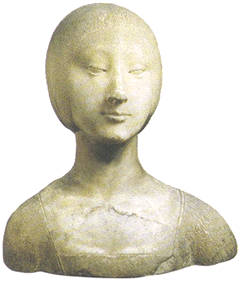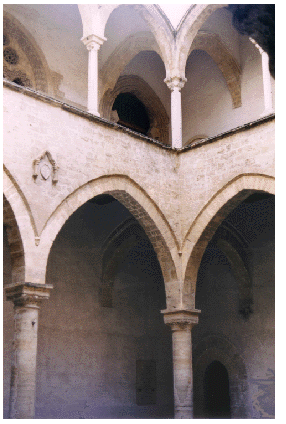...Best of Sicily presents... Best of Sicily Magazine. ... Dedicated to Sicilian art, culture, history, people, places and all things Sicilian. |
by L. Mendola and V. Salerno | |||||
Magazine Index Best of Sicily Arts & Culture Fashion Food & Wine History & Society About Us Travel Faqs Contact Map of Sicily
|
The royal house of Aragon effectively ruled Sicily from the time of the War of the Vespers in 1282, when the conspiracy of Sicilian nobles acting against Charles of Anjou, King of Naples and Sicily, brought about a popular uprising that ousted thousands of Angevins from the island. King Peter of Aragon, whose wife was considered the last heir of the Hohenstaufen dynasty of Swabia, thus became King of Sicily, succeeded in turn by two of his sons. In principle, the crowns of Aragon and Sicily were to remain separate, meaning that the same prince could not simultaneously be king of both Aragon and Sicily. In practice, of course, this was not always the case. In 1302, a treaty known as the Peace of Caltabellotta (for the city where it was signed) established an Angevin-Aragonese truce. By that time, the dynasties of Aragon and Naples were related through marriage, and the Aragonese presence was well-established in Sicily. The House of Anjou, meanwhile, cast its aspirations toward Hungary and elsewhere, and the Neapolitan crown was inherited by the House of Aragon in the middle of the fifteenth century. Initially, the Aragonese period brought peace and prosperity to Sicily. This was sometimes interrupted by periods of unrest, and the nobility never seemed content. Yet it was during this era that most of Sicily's remaining castles and medieval palaces were constructed. Pure Gothic styles were rarely followed. Instead, various Romanesque styles flourished, often enhanced by certain Gothic features and therefore called "Gothic." The Chiaramonte Gothic style was associated with one of the noble families of Sicily which (as we shall see), in the absence of a resident king, usurped royal power for several decades. This was essentially a continuation of the Swabian style used in fortified structures. In the fifteenth century, as the "closed" fortified residences (castles) gave way to more airy "modern" palaces, the Catalan Gothic style was influenced by Aragonese and Catalonian trends, while the Renaissance Gothic style was based on northern Italian architecture. In general, however, the Renaissance influence --despite exceptional artists such as Antonello da Messina-- was minimal in Sicily compared to northern Italy. Nevertheless, in churches statues gradually replaced icons and bas-reliefs, and outside the Church a few enlightened patrons supported the arts. Socially, feudalism became the norm, though in reality (despite claims to the contrary) very few Sicilian noble families identified in the eighteenth century are descended in the male line from ancestors living before 1400. Also, most Sicilians bearing Spanish surnames are descended not from Aragonese forebears but from Spanish ones arriving well after 1500. There were very few Orthodox communities in Sicily after 1300, though an influx of Albanians arrived two centuries later. As far as we know, the Muslims had all converted to Catholicism by 1300. Whereas many towns had once had thriving Jewish communities, most Jews were now migrating to the larger cities. By 1400, Sicily was an essentially Roman Catholic and "Latin" country. The Aragonese introduced a number of nobles to the island, and envy by
the native "Latin" nobility, represented by families such as the
Chiaramonte, provoked a destructive "war" against the Alagona
and other "Catalan" clans, who ostensibly acted in Aragonese interests.
The roots of this movement can be traced to certain families seizing fiefs
formerly belonging to the defeated Angevin nobility, but simple greed and
avarice were the The Chiaramonte (probably descended from the Norman nobility) built castles across Sicily. In Palermo, their socio-economic rivalry with the local Grua family became architectural, pitting the Steri palace (shown here) against the Sclafani palace --both constructed as fortresses just in case the need for defence should arise. The legitimate rulers could not afford to be absent forever. In 1392, Martin of Aragon was crowned king. The Alagonas, Peraltas, Ventimiglias, Gruas and Artales were brought under control, but the deepest royal wrath was reserved for the arrogant Chiaramontes, the last of whom was hung before his lavish residence in Palermo, which became the royal palace and viceroy's residence of Sicily. (It later became the local seat of the Inquisition.) Usurping royal prerogatives and riches was a dangerous game. During the Aragonese period a number of foreigners were present in Sicilian cities. Catalan cloth merchants, Genoese traders, Venetian bankers and even English vendors arrived. Today, certain urban churches reflect the heritage of these communities. Saint Joseph of the Neapolitans and Saint George of the Genoans, both in Palermo, come to mind. In the country, however, deforestation continued in an effort to provide timber for the building of Aragonese ships. It isn't difficult to imaging the overzealous Chiaramontes and Ventimiglias destroying entire forests for economic gain. In Spain, the fall of Granada, the unification of the nation under what became a single dynasty, and the expulsion (or conversion) of the last non-Christians --Jews and some remaining Muslims-- in 1492 mark the beginning of the modern "Spanish" era. The arrival of Columbus in America in the same year definitively removed the Mediterranean, and its largest island, from the stage of world events. In the immediate aftermath of these developments, the kings of Spain were also kings of Sicily, though the Sicilian crown was to be passed from dynasty to dynasty in the centuries to follow. There were no more Muslims in Sicily, but most of the island's Jews converted to Catholicism. As many Jews left, this had a negative effect on the economy of cities such as Palermo. Until around 1500, Messina was the second most important city in Sicily. Henceforth, Catania gradually challenged her for importance in the eastern part of the island. Except for a few years of resurgent independent feeling every few decades --usually coinciding with a "parliament"-- national Sicilian identity gradually declined after 1300. By 1492, it was all but invisible. Even following the Vespers, most "parliaments" held in Sicily under Angevin rule were little more than meetings of barons convened on royal authority, usually with the purpose of "confirming" royal proposals. Despite isolated prosperity, Aragonese Sicily was undistinguished for economic or social initiative, and was usually exploited to support Aragon's treasury and wars. In many ways, the Sicilian nobility became a sleepy, unmotivated social class uninterested in genuine economic development or progress. A true middle class failed to develop, and literacy decreased at a frightening rate. These conditions worsened under Spanish rule in the decades and centuries to come. Coupled with foreign --often distant-- rule, a reactionary Catholicism didn't help matters. In the waning years of the Middle Ages, the benefits of an "Italian" Sicily on the model of the northern city-states probably would have outweighed those of a distant "Spanish" one. These harsh realities would haunt the Sicilians well into the twentieth century. About the Authors: Luigi Mendola is the History Editor of Best of Sicily and author of several books. Palermo native Vincenzo Salerno, who contributed to this article, has written biographies of several famous Sicilians, including Frederick II and Giuseppe di Lampedusa. | ||||
Top of Page |
 The Aragonese
period of Sicily can be said to have lasted from 1282 until 1492, bridging
the medieval and modern eras. The Kingdom of Aragon, which by the middle
of the thirteenth century encompassed Catalonia and other lands, was an
ethnically diverse region with its own language and a flourishing capital,
Barcelona. Indeed, Aragon emerged as a powerful "Spanish" state
in an age when most of the Iberian monarchies were struggling against the
Moors, a conflict which was to continue well into the last years of the
fifteenth century. Until the end of the Middle Ages, Spain was not a unified
nation.
The Aragonese
period of Sicily can be said to have lasted from 1282 until 1492, bridging
the medieval and modern eras. The Kingdom of Aragon, which by the middle
of the thirteenth century encompassed Catalonia and other lands, was an
ethnically diverse region with its own language and a flourishing capital,
Barcelona. Indeed, Aragon emerged as a powerful "Spanish" state
in an age when most of the Iberian monarchies were struggling against the
Moors, a conflict which was to continue well into the last years of the
fifteenth century. Until the end of the Middle Ages, Spain was not a unified
nation. real causes. Aggravated by the absence of the king and the presence
of the Plague, the chaos led to much rural destruction for several decades.
real causes. Aggravated by the absence of the king and the presence
of the Plague, the chaos led to much rural destruction for several decades.